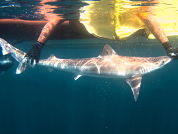Seasonal patterns in Golfo Nuevo and migration on the Argentine shelf of school (Galeorhinus galeus [Linnaeus 1758]) and sevengill (Notorynchus cepedianus [Péron 1807]) sharks (Argentina)
DOI:
https://doi.org/10.25260/EA.16.25.2.0.159Abstract
Knowing the movement patterns of a certain species has substantial implications for its management and conservation, particularly in species that migrate hundreds to thousands of kilometers each year (e.g., many chondrichtyans). The objective of this paper was to study the seasonal abundance in the Golfo Nuevo and the migratory patterns of the school and sevengill shark across the Argentine shelf through a conventional capture-recapture plan. A total of 13 sevengill and 228 school sharks were tagged during a full annual cycle. From analysis of catch per unit effort we found that the species studied show a strong seasonal pattern in the Golfo Nuevo, with higher abundance from mid-Summer to Autumn and a lower one during Spring, when two school shark recaptures were registered north from the tagging site (38º and 40° S). These results represent the first direct evidence supporting the hypothesis of a unique school shark population in the South Atlantic Ocean. Nevertheless, the detection of male school sharks in the study site all year round indicates that at least part of the population could be spending the cold months of the year south of its distribution area. In the case of the sevengill shark, despite that few individuals were captured, the absence of the species during cold months suggest a seasonality similar to the school shark.
References
Barnet, A; KG Abrantes; JD Stevens & JM Semmens. 2011. Site fidelity and sex-specific migration in a mobile apex predator: implications for conservation and ecosystem dynamics. Anim. Behav., 81:1039-1048.
Begon, M; CR Townsend & JL Harper. 2006. Ecology 4th ed. Blackwell Publishing, Victoria, Australia.
Dulvy, NK; SL Fowler; JA Musick; RD Cavanagh; PM Kyne; et al. 2014. Extinction risk and conservation of the world’s sharks and rays. eLife, 3:e00590.
Elías, I; A Rodríguez; E Hasan; MV Reina & R Amoroso. 2005. Biological Observations of the Tope Shark, Galeorhinus galeus, in the Northern Patagonian Gulfs of Argentina. J. Northw. Atl. Fish. Sci., 35:261-265.
Ferretti, F; B Worm, GL Britten; MR Heithaus & HK Lotze. 2010. Patterns and ecosystem consequences of shark declines in the ocean. Ecol. Lett., 13:1055-1071.
Góngora, ME; ND Bovcon & PD Cochia. 2009. Fish bycatch in the Patagonian shrimp fishery Pleoticus muelleri Bate 1888. Rev. Biol. Mar. Oceanogr., 44:583-593.
Guzmán, L & I Campodónico. 1976. Notorynchus cepedianus (Péron, 1807) en la entrada oriental del Estrecho de Magallanes (Elasmobranchii, Hexanchiidae). Anales del Instituto de la Patagonia, 7:207-210.
Helfman, GS; BB Collette; DE Facey & BW Bowe. 2009. The Diversity of Fishes. Biology, Evolution, and Ecology. Wiley-Blackwell, Oxford, UK.
Irigoyen, AJ & G Trobbiani. Depletion of trophy large-sized sharks populations of the south-western Atlantic: insights from fishers’ knowledge. Fisheries Manag. Ecol., (en revisión).
Kohler, NE & PA Turner. 2001. Shark tagging: a review of conventional methods and studies. Environ. Biol. Fishes., 60:191-223.
Lucifora, LO; RC Menni & AH Escalante. 2004. Reproductive biology of the school shark, Galeorhinus galeus, off Argentina: support for a single south western Atlantic population with synchronized migratory movements. Environ. Biol. Fishes, 71:199-209.
Lucifora, LO. 2003. Ecología y Conservación de Los Grandes Tiburones Costeros de Bahía Anegada, Provincia de Buenos Aires, Argentina. Tesis Doctoral, Universidad Nacional de Mar del Plata, Mar del Plata, Argentina.
Peres, MB & CM Vooren. 1991. Sexual development, reproductive cycle, and fecundity of the school shark Galeorhinus galeus off southern Brazil. Fish. Bull., 89:655-667.
Pérez, M; M Braccini & MB Cousseau. 2014. Uso de marcas convencionales en un país con escasa experiencia en marcación de peces marinos. Lat. Am. J. Aquat. Res., 42(1):258-263.
Robledo-Arnuncio, JJ & SC González Martínez. 2009. Marcadores moleculares y ecología del movimiento. Ecosistemas, 18(1):44-51.
Sadowsky, V. 1970. First record of broad-snouted seven-gilled shark from the Cananéia, Brazil. Boletim do Instituto Paulista de Oceanografia, 18:33-35.
Speed, CW; IC Field; MG Meekan & CJA Bradshaw. 2010. Complexities of coastal shark movements and their implications for management. Mar. Ecol. Prog. Ser., 408:275-293.
Stevens, JD; R Bonfil; NK Dulvy & P Walker. 2000. The effects of fishing on sharks, rays and chimaeras (Chondrichthyans), and the implications for marine ecosystems. ICES J. Mar. Sci., 57:476-494.
Vooren, CM. 1997. Demersal elasmobranchs. Pp. 141-146 en: Seeliger, U; C. Odebrecht & JP Castello (eds.). Subtropical Convergence Environments: The Coast and Sea in the Southwestern Atlantic. Springer-Verlag, Heidelberg, Alemania.

Downloads
Published
How to Cite
Issue
Section
License
Copyright (c) 2015 Alejo Irigoyen, Carolina Sibbald, Mariano Cuestas, Franco Cristiani, Gastón Trobbiani

This work is licensed under a Creative Commons Attribution 3.0 Unported License.
Authors retain their rights as follows: 1) by granting the journal the right to its first publication, and 2) by registering the published article with a Creative Commons Attribution License (CC-BY 4.0), which allows authors and third parties to view and use it as long as they clearly mention its origin (citation or reference, including authorship and first publication in this journal). Authors can make other non-exclusive distribution agreements as long as they clearly indicate their origin and are encouraged to widely share and disseminate the published version of their work.


